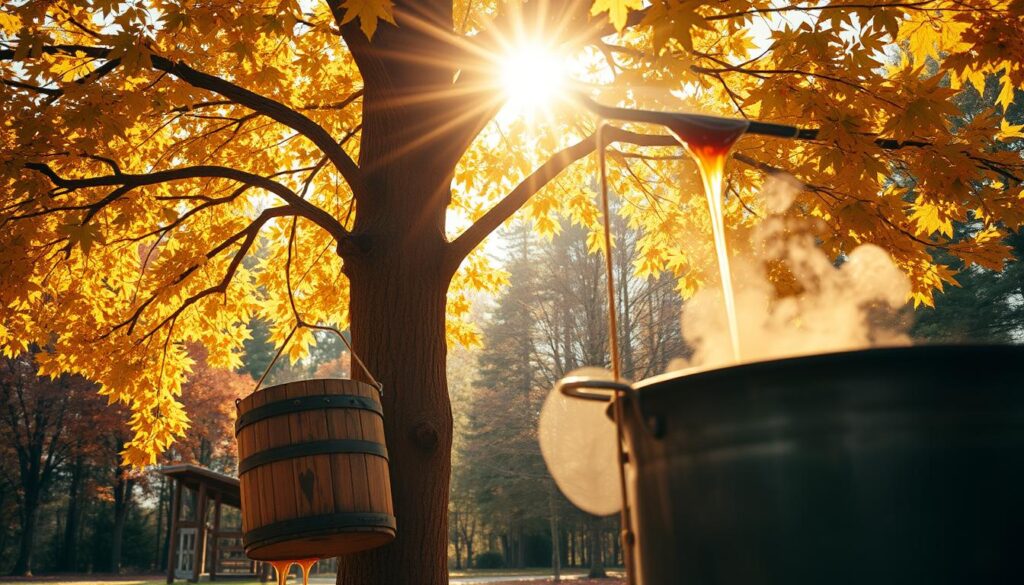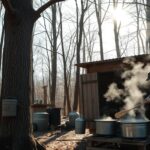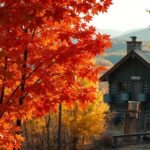Imagine turning a simple maple tree into liquid gold. The journey from tree to table is fascinating. Each maple tree has incredible sweet success waiting to happen.
Sugarmakers in North America know the magic of making maple syrup. They start with a tree that can produce a lot of syrup. One mature tree can give between 10 to 20 gallons of sap in a season.
Curious about how much syrup one tree can make? Each tree has its own story. It depends on the tree’s health, the weather, and how it’s tapped. Not all trees make the same amount of syrup.
The science behind making maple syrup is complex but interesting. Things like temperature, tree age, and where the tree is located matter a lot. Some trees give a lot of sap, while others give less.
Producers use special methods to get the most syrup from their trees. They need patience, skill, and respect for nature’s cycles. This turns simple sap into a treasured food.
As you learn more, you’ll see how maple syrup is made. You’ll learn about tapping, converting sap into syrup, and more. This makes breakfasts across America taste amazing.
Understanding Maple Tree Basics for Syrup Production
Maple syrup harvesting starts with knowing the basics of maple trees. Not all maple trees are good for making syrup. You need to know which species are best, how healthy the trees are, and the environment they’re in.
Maple Species and Sap Production
Not all maple trees are created equal for syrup making. The best ones for syrup are:
- Sugar Maple (Acer saccharum): Highest sugar content, premium syrup production
- Black Maple (Acer nigrum): Similar characteristics to sugar maple
- Red Maple (Acer rubrum): Good alternative with moderate sap yield
Optimal Tree Age and Size for Tapping
The best maple trees for syrup are mature and have certain features. Sugarmakers suggest:
| Tree Age | Minimum Diameter | Recommended Taps |
|---|---|---|
| 40+ years | 10-12 inches | 1-2 taps per tree |
| 80+ years | 18-20 inches | 2-3 taps per tree |
Geographic Regions for Maple Syrup Production
Maple syrup making depends a lot on where you are. The maple belt covers parts of northeastern United States and southeastern Canada. It needs:
- Cold winters with temperatures below freezing
- Moderate spring temperatures around 40-50°F
- Regions with hardwood forests
Knowing these basics is key for making maple syrup. Each tree can make this tasty natural sweetener.
The Science Behind Maple Sap Flow
The process of making maple syrup is based on amazing natural events. It turns the biology of trees into a sweet treat we all love. By understanding how sap flows, we see the magic behind maple syrup.
Temperature is key in making sap move. In winter, maple trees store starches in their roots and trunk. When it gets cold at night and warm during the day, the tree changes in special ways.
- Freezing nights create negative pressure in tree cells
- Daytime warming generates positive pressure
- This pressure differential forces sap to move through tree tissues
Osmotic pressure is also important in making syrup. The tree’s internal pressure changes help push nutrients up. The perfect temperature for sap movement is between 40-50°F.
| Temperature Range | Sap Flow Characteristics |
|---|---|
| Below 32°F | Minimal Sap Movement |
| 32-40°F | Limited Sap Production |
| 40-50°F | Peak Sap Flow Conditions |
| Above 50°F | Decreasing Sap Quality |
Sugarmakers watch these scientific rules closely to get the most syrup. The balance between cold and warm nights is just right for making syrup.
How Much Maple Syrup Can I Get from One Tree?
Maple syrup making is a complex process. It depends on many factors. People often ask how much syrup one tree can make. This depends on the tree’s health, age, and the environment.
On average, a maple tree can give 10 to 20 gallons of sap each year. Not all of this sap becomes syrup. It takes about 40 gallons of raw sap to make just one gallon of maple syrup.
Average Sap Collection Rates
Mature maple trees give the most sap. Here are the main factors that affect sap collection:
- Tree diameter: Trees 10-20 inches in diameter yield the most sap
- Tree age: Trees 40-100 years old produce optimal amounts
- Species: Sugar maples generate the highest sap volumes
Sap-to-Syrup Conversion Ratios
Knowing how sap turns into syrup is key. The standard ratio is:
- 40:1 sap-to-syrup ratio
- 10 gallons of sap = approximately 1 quart of syrup
- Boiling concentrates natural sugars
Seasonal Yield Variations
Seasonal changes greatly affect syrup production. The best time to tap trees is when it’s around 40°F during the day and freezes at night. These conditions help sap flow, leading to more syrup.
Essential Tools and Equipment for Maple Tapping
Maple syrup harvesting needs special tools and equipment. These tools turn tapping maple trees into a precise craft. Sugarmakers pick their gear carefully to collect sap well and make high-quality syrup.
The main tools for maple syrup harvesting are:
- Spiles (Taps): Metal or plastic spouts inserted into maple tree bark to channel sap
- Collection buckets or tubing systems
- Cordless or hand drills for precise tree tapping
- Sanitization supplies for maintaining equipment cleanliness
- Storage containers for raw sap collection
Modern tapping maple trees methods have changed a lot. Now, we use tubing networks instead of buckets. These systems connect many trees, making sap collection more efficient and less stressful for the trees.
Choosing the right equipment depends on a few things:
- Scale of maple syrup production
- Available budget
- Personal expertise level
- Number of maple trees accessible
Keeping tapping equipment in good shape is key. It helps sap flow well and keeps it clean. Use stainless steel and food-grade materials for all tools that touch sap.
Professional sugarmakers know that good equipment is an investment in great maple syrup.
Best Time of Year to Tap Maple Trees
Maple syrup production is all about knowing when to tap maple trees. It’s a balance between nature’s timing and the skill of sugarmakers.
For successful tapping, the weather must be just right. The best time is late winter to early spring. This is when the sap flows best.
Weather Conditions for Optimal Sap Flow
Maple sap flows best under certain weather conditions. Sugarmakers watch for:
- Daytime temperatures above 40°F (4°C)
- Nighttime temperatures below 32°F (0°C)
- Consistent freeze-thaw cycles
These weather patterns create pressure inside the tree. This pressure pushes the sap through the tree’s channels.
Duration of Tapping Season
The maple syrup season usually lasts 4-6 weeks. This can vary based on where you are. Places like Vermont and New Hampshire have longer seasons than the south.
Seasonal changes and climate shifts affect tapping times. Sugarmakers must be flexible and watchful.
“Timing is everything in maple syrup production” – Traditional Sugarmaker Wisdom
Proper Tree Tapping Techniques
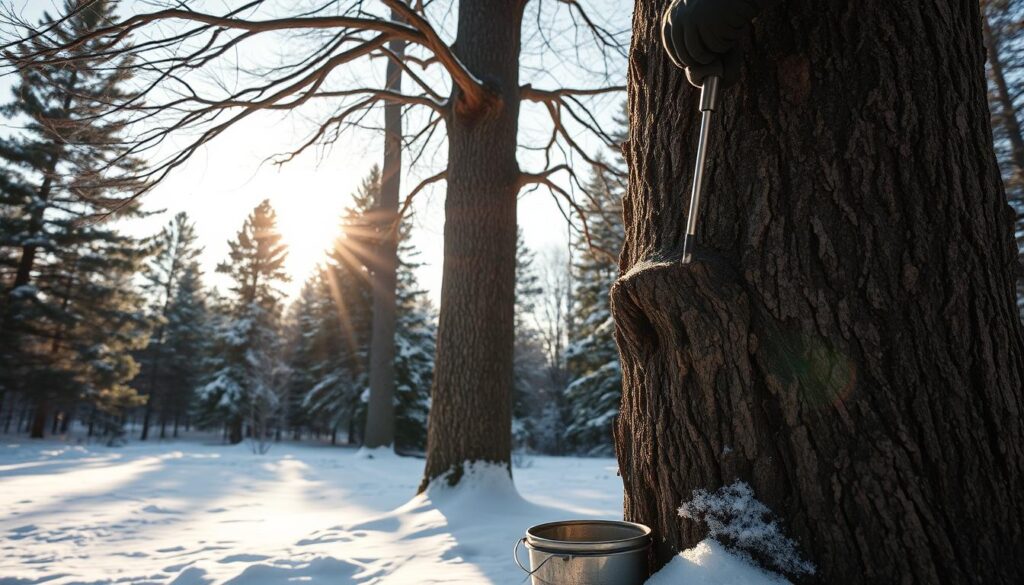
Tapping maple trees is a delicate art that needs precision and care. The maple syrup extraction process starts with picking the right tree. It also involves using the right techniques to collect sap without harming the tree.
Before tapping maple trees, sugarmakers must think about a few key things:
- Tree diameter and health
- Location of tap placement
- Drilling technique
- Type of tap equipment
When picking a spot to tap maple trees, look for healthy trees with a diameter of at least 10 inches. The best spot is on the south-facing side of the tree, where sunlight helps sap flow. Avoid areas with wounds or old tap holes.
The way you drill is very important in the maple syrup extraction process. Use a clean, sharp drill bit made for maple tapping. Drill at a slight angle, about 1.5 to 2 inches deep. The hole should be 5/16 inches wide for standard maple taps.
- Clean the drill bit before each use
- Drill carefully to avoid splitting tree bark
- Insert the tap gently
- Attach collection equipment
Experts say to limit taps on a tree based on its size. A tree 10-20 inches in diameter can handle one tap. Larger trees can have more taps without harming the tree.
“Respect the tree, and it will provide sap for years to come.” – Maple Syrup Producers Association
Change tap locations each season to let old sites heal. This keeps your maple trees healthy for years.
Sustainable Tapping Practices for Long-term Production
Sustainable maple syrup production needs careful planning and wise use of maple trees. Sugarmakers know that keeping trees healthy is key for long-term sap flow. They use smart practices to keep their maple stands productive for years to come.
It’s more than just getting sap from trees. Responsible forest managers use detailed tree care and harvesting plans. These plans help trees stay healthy and strong.
Tree Health Maintenance Strategies
Keeping maple trees healthy involves several steps:
- Regular tree checks for diseases and pests
- Correctly healing wounds and managing tap holes
- Feeding trees well through soil care
- Keeping roots safe from damage
Rotation Systems for Sustainable Harvesting
Using a rotation system is key for sustainable syrup making. It lets trees rest and recover between tapping seasons.
| Tapping Rotation Strategy | Recovery Period | Long-term Benefits |
|---|---|---|
| 3-4 Year Rotation | 1-2 Years | Reduced Tree Stress |
| Selective Tap Placement | Continuous | Improved Sap Flow |
| Minimum Tap Diameter | Annual Assessment | Tree Health Preservation |
By managing tapping wisely, sugarmakers can care for their trees and keep sap flowing. Sustainable maple syrup production is all about finding the right balance between harvesting and protecting trees.
Collecting and Storing Maple Sap
Maple syrup harvesting is all about collecting and storing sap right. It starts with knowing when to collect sap during the maple syrup season.
Sugarmakers use two main ways to collect maple sap:
- Traditional Bucket Method
- Hand-tapped trees with metal or wooden buckets
- Great for small-scale syrup making
- Let’s you see how much sap you’re getting
- Modern Tubing Systems
- Plastic tubes connect many trees
- Best for big syrup making operations
- Less work and faster sap collection
Storing sap is key in maple syrup making. Sap needs to stay cold and clean to avoid bacteria. Pro sugarmakers keep it below 38°F to keep it top quality.
“The key to exceptional maple syrup is not just in the tapping, but in the careful collection and immediate storage of the sap.” – Vermont Maple Sugar Makers Association
How often you collect sap depends on the weather and sap flow. In the peak season, you might need to collect sap every 12-24 hours. This helps prevent spoilage and keeps the sap ready for syrup making.
The Syrup Making Process
Maple syrup production turns raw tree sap into a tasty golden liquid. This process needs careful attention to temperature and technique. It’s a journey from sap to syrup that requires skill and precision.
Sugarmakers watch over the maple syrup extraction process closely. They follow several key steps to get high-quality syrup. This process needs special knowledge and tools.
Boiling Techniques for Perfect Syrup
The boiling stage is the core of maple syrup making. Experts use various methods to turn sap into syrup:
- Traditional open-pan evaporators
- Modern reverse osmosis systems
- Wood-fired evaporation methods
Keeping the temperature right is key during boiling. The ideal range is between 219-220 degrees Fahrenheit. This ensures the sap becomes syrup without burning.
Filtering Methods for Clear Syrup
Filtering gets rid of impurities and makes the syrup clear. Sugarmakers use several filtering stages:
- Hot filtering during initial processing
- Gravity-based filtration
- Fine mesh paper filtering
Each filtering step helps remove sediment. This makes the maple syrup smooth and pure. It meets the high standards of the maple syrup industry.
Factors Affecting Syrup Yield
To figure out how much syrup a tree can make, you need to know a lot. It’s all about the environment and the tree itself. Sugarmakers watch these things closely.
What the tree is like matters a lot for syrup making. Here are some key things that affect syrup production:
- Tree age and health
- Diameter of the maple tree
- Species of maple
- Geographic location
- Climate conditions
Older sugar maple trees usually give the most sap. Trees that are 40-80 years old and 10-20 inches wide are best. A healthy tree can make about 10-20 gallons of sap each season.
| Tree Factor | Impact on Syrup Yield |
|---|---|
| Tree Diameter | Directly correlates with sap production capacity |
| Tree Health | Determines overall sap flow efficiency |
| Climate Conditions | Influences sap sugar content and flow rates |
Things like weather, soil, and rain also affect syrup making. Sugarmakers need to know how these things work together to get the most syrup.
By taking care of the trees and tapping them right, sugarmakers can keep making syrup. This also helps the maple forests stay healthy for a long time.
Common Challenges in Maple Syrup Production
Maple syrup making is a delicate art with many obstacles. These can affect both how much syrup is made and its quality. Sugarmakers face a complex mix of environmental, technical, and quality challenges. They must overcome these to produce sustainable maple syrup.
The world of maple syrup making is complex. It requires careful attention to many factors. These factors can greatly impact a season’s syrup harvest.
Weather-Related Hurdles
Weather is a big challenge for maple syrup makers. The right temperature is key for making syrup:
- Unpredictable weather can mess up sap flow
- Too warm winters mean less sap
- Fast changes in temperature can stop production
Equipment Management Challenges
Technical problems can stop syrup production fast. Common issues include:
- Leaking tubing
- Broken evaporators
- Damaged tapping tools
Quality Control Complexities
Keeping syrup quality high is a big job. It requires careful attention to detail. Challenges include:
- Off-flavors from bad collection or processing
- Uneven syrup density
- Contamination risks during handling
Sugarmakers need strong plans to tackle these issues. They aim to make high-quality syrup that meets strict standards.
Maximizing Your Tree’s Syrup Production
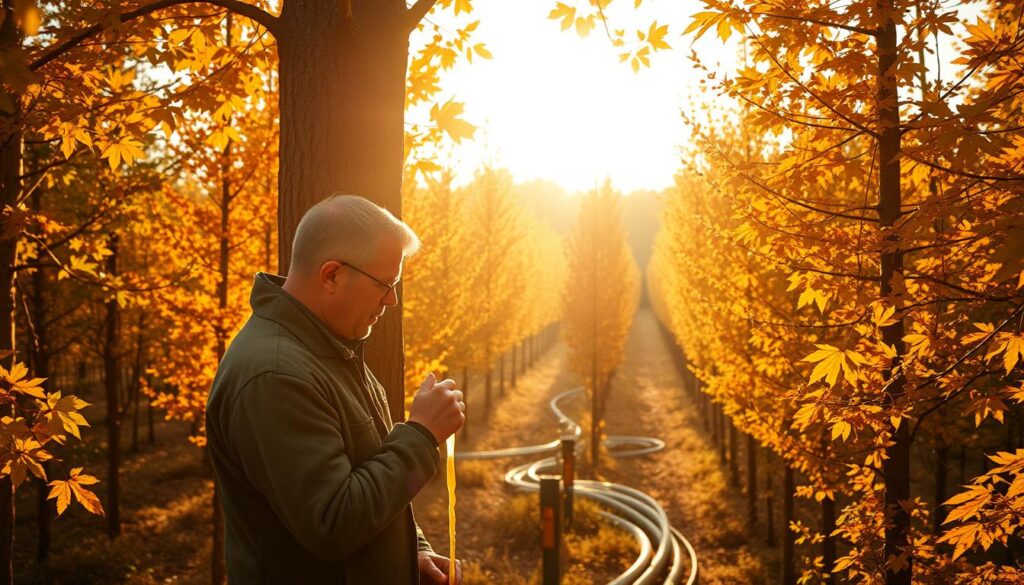
To get the most maple syrup, you need a plan and the right skills. By focusing on sap production and tree health, you can boost your syrup yield. This means more syrup from each tree.
Here are some key strategies for better syrup production:
- Select mature maple trees with optimal diameter (10-20 inches)
- Identify healthy trees with strong bark and branches
- Use careful tapping to avoid harming the tree
Getting your trees ready is essential. Experts say to pick the right spot for taps to avoid stressing the tree. Choosing the right spot helps keep sap flowing well and keeps the tree healthy.
“A healthy tree is the foundation of exceptional maple syrup production” – Traditional Maple Farming Wisdom
Today, we have new tools to help us manage syrup production. Wireless sensors track sap flow, temperature, and humidity. This lets us manage syrup production more accurately.
- Install digital monitoring equipment
- Track environmental conditions
- Optimize collection timing
Keeping your practices green is important for syrup quality. Rotate tap spots, give trees time to recover, and use few taps. This keeps trees healthy and syrup production steady.
Quality Assessment of Maple Syrup
Maple syrup production is more than just collecting sap. It requires careful evaluation of several key factors. Professional sugarmakers know that the grading system is vital for the syrup’s value and marketability.
Understanding Maple Syrup Grading Systems
Quality maple syrup calculations involve several criteria. These criteria categorize the syrup into different grades. The grades show the syrup’s color, flavor, and clarity. A standardized system ensures consistent quality in maple syrup production.
- Grade A Golden Color, Delicate Taste: Lightest color with mild maple flavor
- Grade A Amber Color, Rich Taste: Slightly darker with more pronounced maple characteristics
- Grade A Dark Color, Robust Taste: Deep color with strong maple flavor
- Grade A Very Dark Color, Strong Taste: Darkest grade with intense maple notes
Essential Storage Requirements
Keeping maple syrup quality means using the right storage methods. The right temperature and container are key to keeping the syrup’s unique taste and preventing spoilage.
Ideal storage conditions include:
- Cool, dark environments
- Sealed glass or food-grade containers
- Refrigeration after opening
- Protection from direct sunlight
Proper storage ensures that the nuanced flavors developed during maple syrup production remain intact for enjoying nature’s sweet treasure.
Economic Value of Single-Tree Production
Learning about maple syrup yield per tree shows a great economic chance for landowners and those into farming. A single mature maple tree can bring in good money. This makes maple syrup production a great option.
The value of maple syrup production depends on a few key things:
- Tree maturity and health
- Regional climate conditions
- Tapping techniques
- Market prices for maple syrup
Experts say a healthy maple can make about 10-20 gallons of sap each season. This means around 1 quart of pure maple syrup. It can sell for $30 to $50 per gallon.
“Maple syrup production is not just a tradition, it’s a sustainable economic opportunity for rural communities.” – Maple Syrup Producers Association
Producers can also make extra money by creating special products like:
- Maple candy
- Maple cream
- Infused maple syrups
- Specialty gift packages
Starting up with tapping equipment costs $200 to $500. But, the money you make each year can pay for it in just a few seasons.
Environmental Impact of Maple Syrup Production
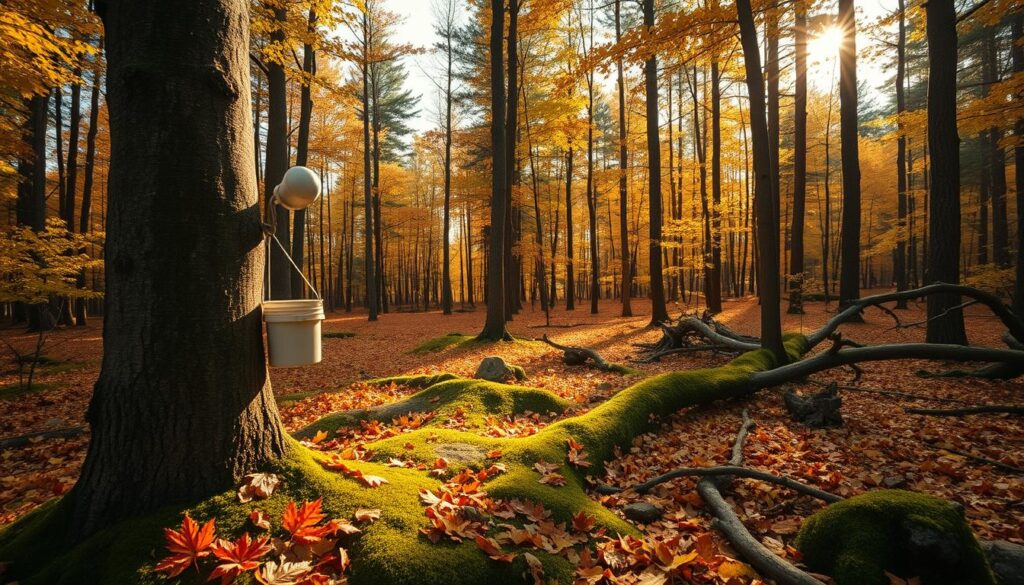
Sustainable maple syrup production is key to keeping forests healthy. It helps keep the forest diverse and protects animal homes. Unlike many farming methods, it actually helps keep forests intact.
Maple forests are big carbon sinks, pulling a lot of carbon dioxide out of the air. When sugarmakers tap trees carefully, they help the environment and make a valuable food. This way, maple trees stay healthy and keep giving back to the planet.
- Carbon sequestration by mature maple trees
- Preservation of forest biodiversity
- Minimal ecosystem disruption during maple syrup harvesting
- Sustainable forest management practices
Using less energy is a big part of making maple syrup sustainably. Modern sugarhouses use solar and biomass power. Innovative technologies are making maple syrup production greener.
Responsible maple syrup harvesting represents a harmonious relationship between human agricultural practices and natural forest ecosystems.
Wildlife also wins with sustainable maple syrup production. Healthy forests mean more homes for animals and plants. By tapping trees wisely and not harming the forest too much, sugarmakers help keep nature in balance.
Conclusion
Learning about maple syrup production is a journey into nature’s secrets. It’s a mix of science, skill, and respect for the environment. Each maple tree can make different amounts of syrup, based on its health and the weather.
Maple syrup making is more than just numbers. An average tree can give 10 to 20 gallons of sap each season. But turning that sap into syrup takes patience and precision. Sugarmakers see it as an art that requires understanding trees and the land.
Starting to make maple syrup is exciting and rewarding. It teaches you to value sustainable farming and connect with nature. Whether you’re just starting or planning to make syrup for a living, it’s a unique chance to join a long-standing tradition in the U.S.
This guide helps you understand maple syrup production better. It’s not just about making food; it’s a celebration of nature’s gifts and human talent working together.

